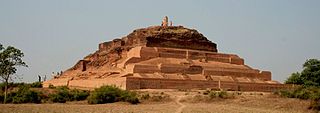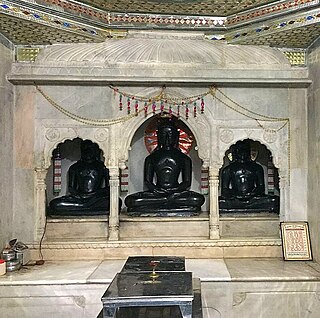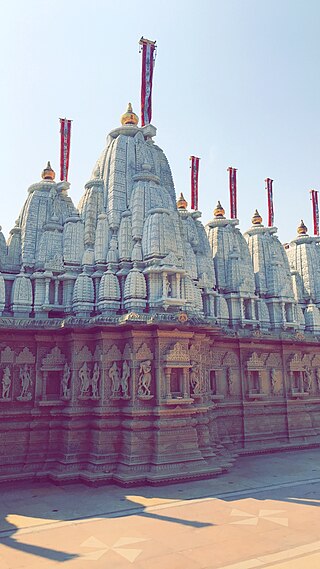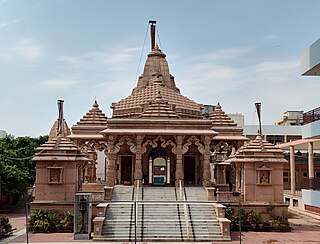The Vaghela dynasty ruled the Gujarat region in India in the 13th century CE, with their capital at Dholka. They were the last Hindu dynasty to rule Gujarat before the Muslim conquest of the region.

Parshvanatha, or Pārśva and Pārasanātha, was the 23rd of 24 Tirthankaras of Jainism. He gained the title of Kalīkālkalpataru.

Suparshvanatha, also known as Suparśva, was the seventh Jain Tīrthankara of the present age (avasarpini). He was born to King Pratistha and Queen Prithvi at Varanasi on 12 Jestha Shukla in the Ikshvaku clan. He is said to have attained moksha at Shikharji on the sixth day of the dark half of the month of Phālguna.

Śāntinātha or Śānti is the sixteenth Tīrthaṅkara of Jainism in the present age. According to traditional accounts, he was born to King Vishvasena and Queen Aćira of the Ikshvaku dynasty in the north Indian city of Hastinapur. His birth date is the thirteenth day of the Jyest Krishna month of the Indian calendar. He was also a Chakravarti and a Kamadeva. He ascended to the throne when he was 25 years old. After over 25,000 years on the throne, he became a Jain monk and started his penance.

Ahichchhatra or Ahikhet or Ahikshetra, near the modern Ramnagar village in Aonla tehsil, Bareilly district in Uttar Pradesh, India, was the ancient capital of Northern Panchala, a northern Indian kingdom mentioned in the Mahabharata.

Golapurva is an ancient Digambar Jain community from the Bundelkhand region of Madhya Pradesh.

The Shankheshwar Jain Temple is located in the center of Shankheshwar town of Patan district, Gujarat, India. The temple is dedicated to Parshwanath and is an important place of pilgrimage for the followers of Jainism.

Kulpakji also Kolanupaka Temple is a 2,000 year-old Jain temple at the village of Kolanupaka in Aler City, Yadadri Bhuvanagiri district, Telangana, India. The temple houses three deities: one each of Lord Rishabhanatha, Lord Neminatha, and Lord Mahavira. The image of Lord Rishabhanatha, carved of a green stone has been historically famous as "Manikyaswami" and Jivantasvami. The temple is about 80 km from Hyderabad on the Hyderabad-Warangal Highway NH 163.
Vidyadhar Pasusa Johrapurkar is a Sanskritist, social anthropologist and historian. His name is sometimes spelt as Vidyadhar Pasusa Joharapurkar. He specializes in Jainism and Jain philosophy.

Kharatara Gaccha is one of Śvetāmbara Murtipujaka Gacchas. It is also called the Vidhisangha or Vidhimarga, as they regard their practices as scripturally correct.

The Palitana temples, often known only as Palitana, are a large complex of Jain temples located on Shatrunjaya hills near Palitana in Bhavnagar district, Gujarat, India. Also known as "Padliptapur of Kathiawad" in historic texts, the dense collection of almost 900 small shrines and large temples have led many to call Palitana the "city of temples". It is one of the most sacred sites of the Śvetāmbara tradition within Jainism. The earliest temples in the complex date as far back as the 11th century CE.

Aranath(Arnath) was the eighteenth Jain Tirthankar of the present half cycle of time (Avasarpini). He was also the eighth Chakravartin and thirteenth Kamadeva. According to Jain beliefs, he was born around 16,585,000 BCE. He became a siddha i.e. a liberated soul which has destroyed all of its karmas. Aranath was born to King Sudarshana and Queen Devi (Mitra) at Hastinapur in the Ikshvaku dynasty. His birth date was the tenth day of the Migsar Krishna month of the Indian calendar.

Parshvanath Jain temples, Varanasi a group three Jain temples located in Bhelupur, Uttar Pradesh. The temples in Bhelupur were built to commemorate place for three kalyanaka of Parshvanatha.

Nirvana Kanda is an ancient Prakrit Jain composition that describes the sacred sites where Jain sages have attained Nirvana. It is also termed Nirvana Bhakti.
Prabandha is a literary genre of medieval Indian Sanskrit literature. The prabandhas contain semi-historical anecdotes about the lives of famous persons. They were written primarily by Jain scholars of western India from 13th century onwards. The prabandhas feature colloquial Sanskrit with vernacular expressions, and contain elements of folklore.
Khengara was a Chudasama king of Saurashtra region of western India who reigned in the 12th century. His capital was at Junagadh. He was a contemporary of Jayasimha Siddharaja, the Chaulukya ruler of Anahilapataka. According to bardic tales, he was a son of Navaghana and had succeeded him.
Vastupāla was a prime minister of the Vāghelā king Vīradhavala and his successor Vīsaladeva, who ruled in what is now the Gujarat region of India, in the early 13th century. Although he served in an administrative and military capacity, he was also a patron of art, literature and public works. He, together with his brother Tejapāla, assisted in the restoration of peace in the kingdom, and served in a number of campaigns against Lāṭa, Godraha, Kutch and the Delhi Sultanate. The brothers were instrumental in the construction of the Luniga-vasahi temple on Mount Abu and the Vastupala-vihara on Girnar.

Shobhnath temple is an ancient Jain temple located in the Shravasti city of Uttar Pradesh.

The Ahichchhatra Jain temples is a group of Jain temples in Ahichchhatra village in Aonla tehsil of Bareilly district in Uttar Pradesh, North India. Ahichchhatra is believed to be the place where Parshvanatha, the 23rd Tirthankar of Jainism, attained Kevala Jnana.
Udaya-prabha Sūri was a Jain monk and writer from the Vaghela kingdom of present-day India. He was a member of the literary circle of the minister Vastupala, and wrote several Sanskrit-language works.















